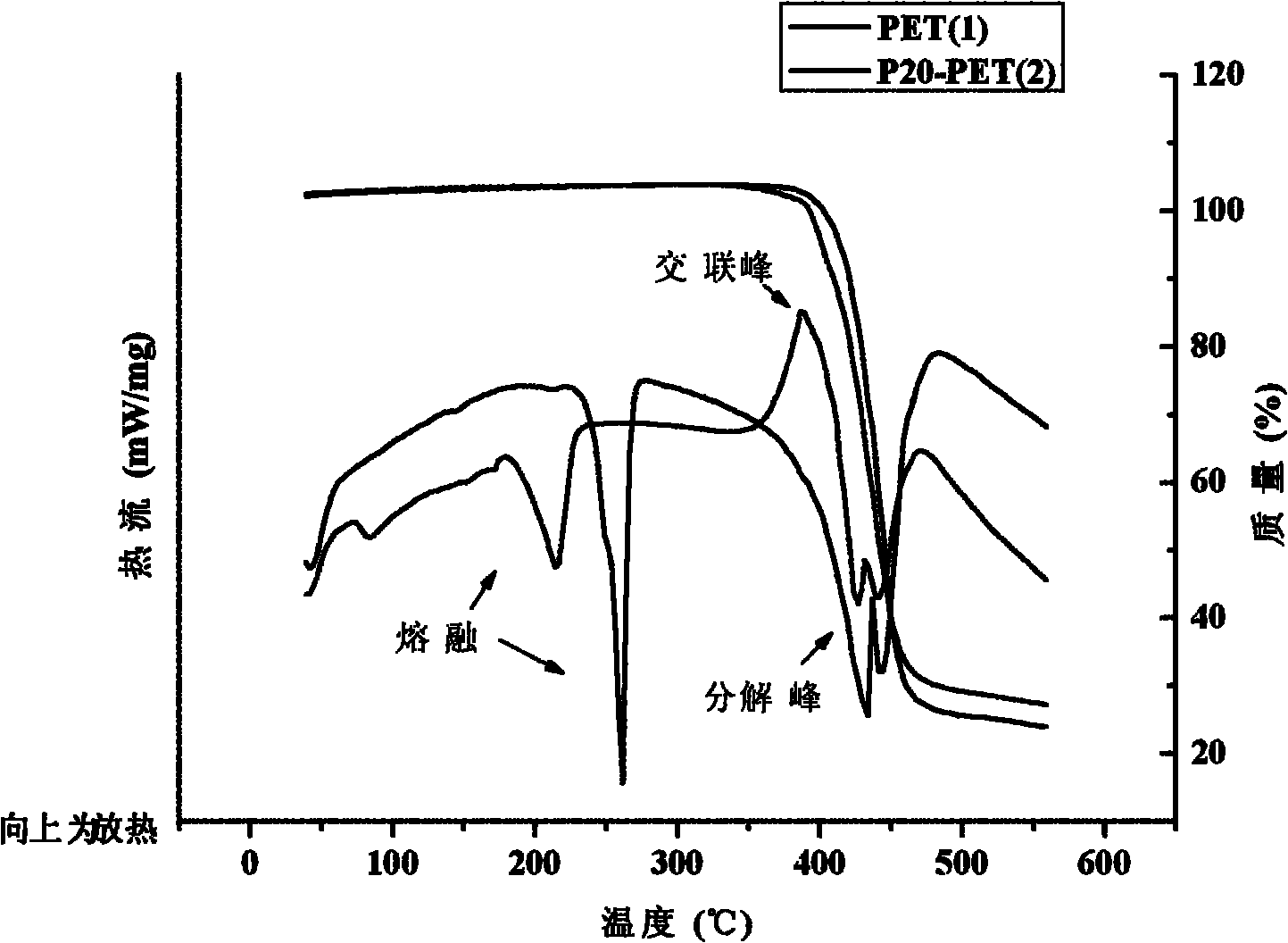High-temperature self-crosslinking flame-retardant anti-dripping copolyester and preparation method thereof
A self-crosslinking and copolyester technology, which is used in the field of flame retardant and anti-droplet copolyester and its preparation, high temperature self-crosslinking, can solve problems such as limiting the application scope of polyester, and achieve excellent resistance. The effect of burning and anti-droplet, good solvent resistance and good char formation
- Summary
- Abstract
- Description
- Claims
- Application Information
AI Technical Summary
Problems solved by technology
Method used
Image
Examples
Embodiment 1
[0041] Add 860g of terephthalic acid, 433mL of ethylene glycol and 0.301g of antimony trioxide into the reaction kettle, fill with nitrogen to remove the air in the kettle, pressurize to 0.1MPa; raise the temperature to 240°C within 2h to start the esterification reaction, control the kettle The internal pressure is 0.3-0.4MPa. After maintaining for 2 hours, the pressure begins to decrease. After 1.5 hours, the temperature gradually rises to 260°C, the pressure drops to normal pressure, and the esterification reaction ends; nitrogen is slowly introduced into the reactor, and 6.89g The ethylene glycol solution of the cross-linking monomer 2-phenylacetylene terephthalic acid is added to the reaction kettle, and the temperature is controlled above 210°C. When the system temperature rises slowly to 260°C, the nitrogen flow is stopped and the vacuum polymerization stage is entered. Firstly, conduct polycondensation reaction in low vacuum at 260-270°C for 0.5h, then raise the tempera...
Embodiment 2
[0044] Add 860g of terephthalic acid, 433mL of ethylene glycol, 13.78g of cross-linking monomer 4-phenylacetylene phthalic anhydride and 0.301g of antimony trioxide into the reactor, and perform esterification according to the steps and conditions given in Example 1 After reaction and polycondensation, discharge.
[0045] The intrinsic viscosity [η] of the polyester is 0.74dL / g; the oxygen index is 23.0%, the vertical combustion level is V-2, and the number of drops from two ignition to extinguishment in the vertical combustion is a total of 25 drops. In the cone calorimetry test The peak heat release rate p-HRR is 820kW / m 2 .
Embodiment 3
[0047] 860g of terephthalic acid, 433mL of ethylene glycol and 0.301g of antimony trioxide were added to the reactor, and the esterification reaction was carried out according to the steps and conditions given in Example 1; Nitrogen, and the crosslinking monomer 5-phenylacetylene-1 of 69.41g, the ethylene glycol solution of 3-isophthalate is added in the reaction kettle, after carrying out polycondensation according to the step and the condition that embodiment 1 provides again, out material.
[0048] The intrinsic viscosity [η] of the polyester is 0.85dL / g; the oxygen index is 25%, the vertical combustion level is V-2, and the number of drops from two ignition to extinguishment in the vertical combustion is a total of 10 drops. In the cone calorimetry test The peak heat release rate p-HRR is 596kW / m 2 .
PUM
| Property | Measurement | Unit |
|---|---|---|
| oxygen index | aaaaa | aaaaa |
| oxygen index | aaaaa | aaaaa |
| oxygen index | aaaaa | aaaaa |
Abstract
Description
Claims
Application Information
 Login to View More
Login to View More - R&D
- Intellectual Property
- Life Sciences
- Materials
- Tech Scout
- Unparalleled Data Quality
- Higher Quality Content
- 60% Fewer Hallucinations
Browse by: Latest US Patents, China's latest patents, Technical Efficacy Thesaurus, Application Domain, Technology Topic, Popular Technical Reports.
© 2025 PatSnap. All rights reserved.Legal|Privacy policy|Modern Slavery Act Transparency Statement|Sitemap|About US| Contact US: help@patsnap.com



